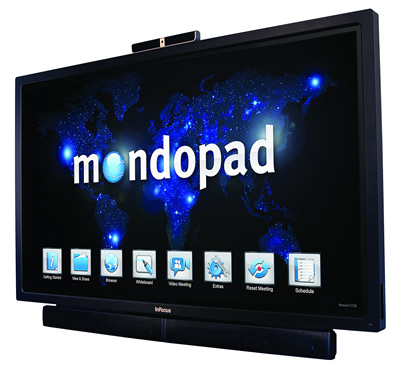KOMO integrates Web, touch control into news reports
As technology reporter for Seattle’s KOMO 4 News, Matt Markovich gets to report on great new technologies – and he also gets to use them in his job.
“The newsroom at KOMO was looking for a large-scale digital display to use on air as a way to present dynamic, Web-based content and display images and live-streaming video during broadcasts,” says Markovich.
High-end progressive-pixel displays offer great-looking images, but they are also expensive and lack the fast interactivity that many people have grown accustomed to with touchscreen tablet computers. For a small TV station with a tight newsroom budget, top-of-the-line LED digital displays were simply not affordable for KOMO.

On a flight to Seattle, Markovich struck up a conversation with the man in the next seat. It turns out he worked in the entertainment industry and used a large-scale touchscreen tablet computer called the InFocus Mondopad to display closed-circuit reviews of daily shoots for movie, commercial and TV producers. “The Mondopad’s features met many of the requirements we were looking for in a digital display to use in broadcasts,” says Markovich, “and before long, the KOMO newsroom was experimenting with a Mondopad.”
As an alternative to costly progressive-pixel displays, the Mondopad offers features not typically found on more passive digital displays. The Mondopad is a fully featured tablet PC, with touch-enabled screen and the functionality of a Windows-based computer. Any content available on the Web can be displayed on its 55in screen, and the drawable interface allows the news team to add its personal highlights to anything on the screen.
As an example, during live news broadcasts KOMO reporters use maps to indicate the location and movement of fires. With the Mondopad, the reporter can pull up the appropriate map from the Web, and then simply draw on the screen to indicate the dynamic movement of the fire. KOMO also has broadcast segments during which news anchors discuss comments from the station’s social media channels. With the Mondopad, they can negotiate Twitter or Facebook directly from the screen, just as on a tablet computer, and display the conversations on the screen for the viewers to read. The Mondopad is also fully mobile, attached to a specially designed rolling cart; with built-in Wi-Fi connectivity, reporters can move it to wherever the broadcast takes them.
The Mondopad was especially useful for the KOMO newsroom during the 2012 elections. News anchors were able to pull live national coverage from Web sources, such as the Associated Press, and intersperse them with video content from local reporters as they covered the results of races closer to home. If reporters wanted to emphasize a point, they simply went to the Mondopad and started drawing on the screen to make the content interactive for viewers. To post files to the Mondopad, reporters e-mail them. Because it has all the capabilities of a PC, they can open and display documents in Word, Excel or other Microsoft Office programs, and manipulate them directly from the touchscreen.
Get the TV Tech Newsletter
The professional video industry's #1 source for news, trends and product and tech information. Sign up below.
For the news team at KOMO, the Mondopad has proved to be a powerful, flexible digital display for use on live broadcast TV at a price that even small stations can afford. “At KOMO, we’re still finding new ways to incorporate the Mondopad into newscasts,” says Markovich, “and since it’s so interactive and easy to learn, it definitely boosts the vitality and enjoyment of broadcasting the nightly news.”
Editor’s Note: Heidi Kayser is managing director of business development for Animation Dynamics in Portland, OR. She formerly was corporate marketing manager for InFocus.
